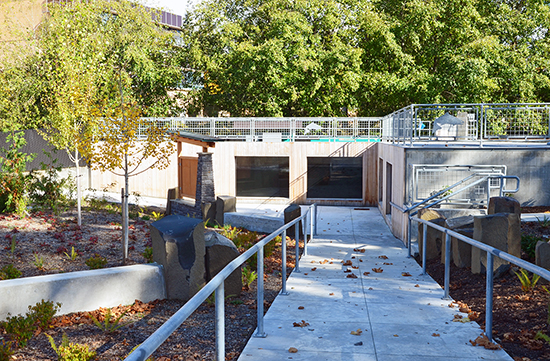|
Subscribe / Renew |
|
|
Contact Us |
|
| ► Subscribe to our Free Weekly Newsletter | |
| home | Welcome, sign in or click here to subscribe. | login |
Construction
| |
 |
February 5, 2021
National finalist: Gold award — Special Projects
HDR

Project: Tumwater Falls Hatchery modernization
Client: Washington State Department of Fish and Wildlife
Built to help spawning salmon traverse the Deschutes River over 50 years ago, the Tumwater Falls Hatchery’s fish ladders needed repair, and its holding ponds had become too small for current needs. The $9 million modernization project built larger holding and rearing ponds, extended the fish ladder, and expanded production quantity to more than 3.8 million chinook salmon annually. The new facilities also improve access for the more than 250,000 annual park visitors to come face-to-face with salmon through new fish viewing windows in the holding ponds and ladder.
The facility upgrades included a new mechanical building to house pumps, backwash equipment and alarms; a new surface water intake; pollution abatement facilities; public restrooms; and a backup generator to keep the facility operable during power outages. The new water diversion system using surface water for holding and rearing fish was paramount because it provides the unique scents that fish use to return to their natural spawning waters. Water quality is preserved downstream by the system that removes excess fish food and waste, and river sediment is controlled to reduce maintenance within the hatchery.
Extensive bedrock, a dam foundation and contaminated soils inside a tight in-water work window presented a host of complexities. While bedrock was expected, it became a challenge to remove it quickly while monitoring noise, staying on schedule, and working in an active community park. The HDR team worked with stakeholders and expedited shop drawings, and reorganized construction activities to circumvent the unforeseen issues to finish in time for the fall chinook run.
HDR’s design team employed a low-impact development strategy with new landscaping and additional impervious surfaces. Stormwater is used to recharge groundwater using bioswales and permeable pavement. This will improve the native vegetation around the site and reduce erosion and water entering the sewer system.
Other Stories:
- National finalist: Platinum award — Structural Systems
Magnusson Klemencic Associates - National finalist: Gold award — Water Resources
Parsons and GeoEngineers - Best in State: Gold award — Future Value to the Engineering Profession
Century West Engineering - Inclusion Award — Midsize firm
- Engineer of the Year
- Best in State: Gold award — Complexity
Notkin, a P2S company - Inclusion Award — Midsize firm
- Best in State: Gold award — Social, Economic and Sustainable Design
Parametrix - National finalist: Gold award — Transportation
HDR - Best in State: Gold award — Unique or Innovative Applications
Parr Excellence - Best in State: Gold award — Successful Fulfillment of Client/Owner Needs
COWI North America and HNTB - National finalist: Gold award — Structural Systems
KPFF Consulting Engineers


